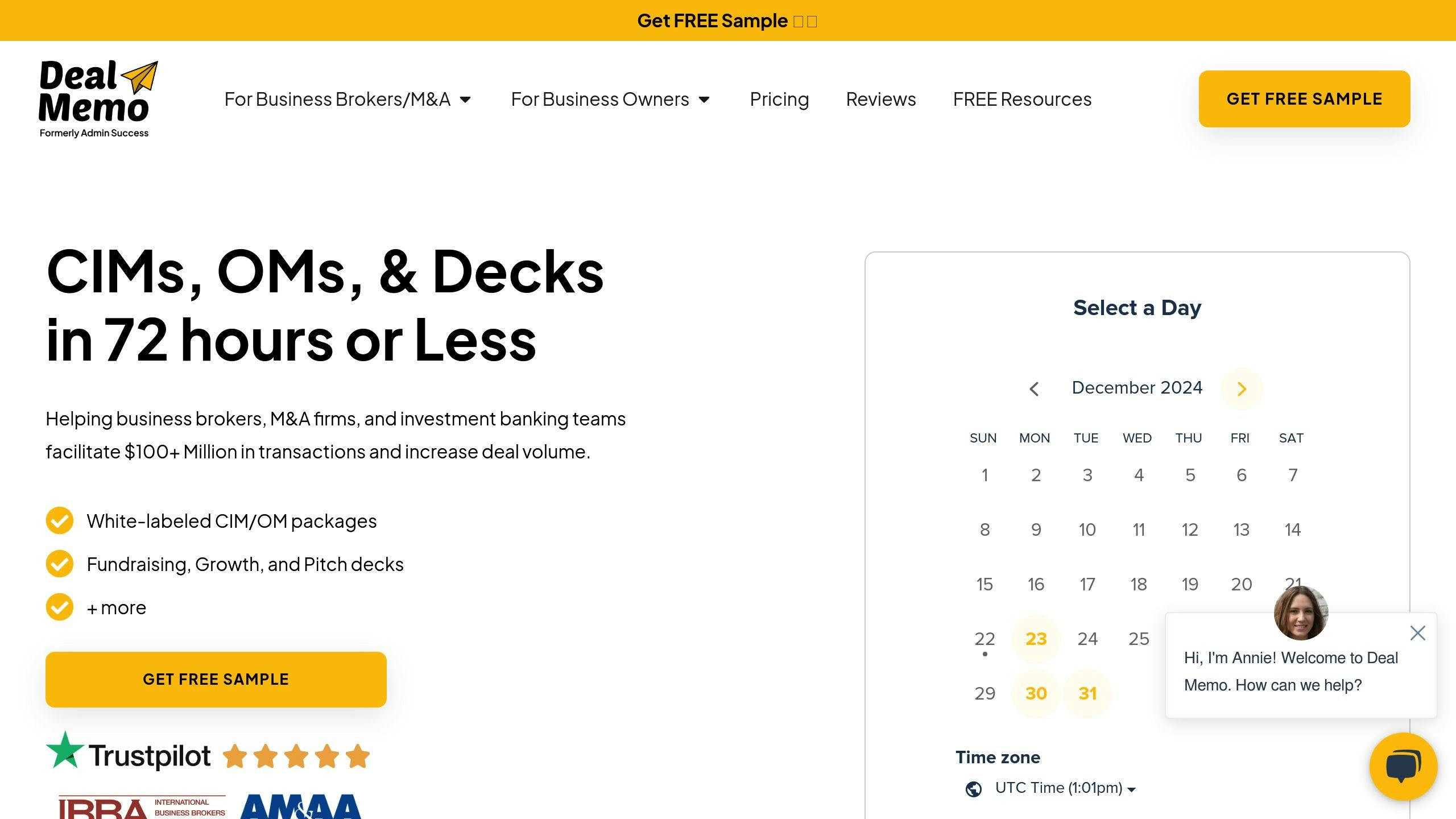A Confidential Information Memorandum (CIM) is a critical document in middle-market mergers and acquisitions (M&A), providing potential buyers with detailed insights into businesses with annual revenues between $10 million and $1 billion. It acts as both a marketing tool and a due diligence resource, highlighting a company’s value, growth potential, and financial health.
Key Takeaways:
- Purpose: Helps buyers evaluate the business, combining financial data, growth strategies, and risk analysis.
- Structure: Includes sections like Executive Summary, Company Background, Financial Data, and Risk Mitigation.
- Challenges: Middle-market companies often face hurdles like limited financial systems, owner dependency, and customer concentration.
- Modern Trends: Digital sharing via virtual data rooms ensures security and efficiency.
Quick Facts:
| Section | Focus |
|---|---|
| Executive Summary | Key selling points, financial highlights |
| Financial Data & Projections | Historical performance and future estimates |
| Risk Mitigation | Strategies to address buyer concerns |
A well-crafted CIM can attract 20% more bids and close deals 30% faster. Whether created in-house or outsourced, it’s essential for a successful M&A process.
How To Analyze M&A Broker CIMs for Business Buyers
Key Sections of a Middle Market CIM
A Confidential Information Memorandum (CIM) for middle-market companies needs to be well-organized, presenting critical information that helps buyers make informed decisions. Each section plays a role in telling the company’s story and supporting its valuation.
Executive Summary and Key Selling Points
The executive summary is the first impression, giving a concise snapshot of the investment opportunity. A 2022 Deloitte survey found that 55% of middle-market executives view this section as essential for their initial review.
| Component | Content Focus | Purpose |
|---|---|---|
| Company Overview | Core business description | Quick understanding of operations |
| Financial Highlights | Key metrics and growth rates | Showcase financial health |
| Market Position | Competitive advantages | Highlight market leadership |
| Growth Strategy | Future opportunities | Present scaling potential |
"The executive summary functions as the company’s elevator pitch. In middle market deals, we’ve found that 80% of potential buyers decide whether to pursue the opportunity further based solely on these first two pages." – Managing Director at a leading middle-market investment bank
After setting the stage with the executive summary, the next step is to build credibility by detailing the company’s history and market position.
Company Background and Market Position
This section focuses on the company’s evolution and its current standing in the market. It highlights operational strengths and unique advantages that set the business apart from competitors.
Key elements include:
- Historical Timeline: Highlight major milestones that showcase growth and market impact.
- Market Analysis: Provide insights into market size, growth trends, and the company’s position within the industry.
- Competitive Landscape: Offer a clear view of how the company compares to competitors, with a focus on differentiators and long-term advantages.
Once the company’s position is established, the financial section provides the hard numbers to back up its valuation.
Financial Data and Projections
Financial data is the backbone of any CIM, giving buyers the numbers they need to evaluate the company’s value and growth potential. This section typically includes three years of historical data alongside three to five years of projections.
Tables and charts are often used to simplify complex data, focusing on:
- Key financial performance metrics
- Capital and customer-related dynamics
- Adjustments to EBITDA for a clearer picture
| Adjustment Category | Amount ($M) | Rationale |
|---|---|---|
| Reported EBITDA | 15.5 | Base figure |
| Owner Compensation | +1.2 | Adjustment to market rates |
| One-time Expenses | +0.8 | Non-recurring legal costs |
| Normalized EBITDA | 17.5 | Adjusted figure |
Tips for Writing a Strong CIM
Now that we’ve covered the key sections of a CIM, let’s dive into some practical tips to make the document clear, engaging, and focused on the buyer. A 2024 Deloitte survey revealed that 78% of M&A professionals view the quality of the CIM as a crucial factor in their decision-making process.
Presenting the Company’s Story Clearly
Your narrative should showcase the company’s journey, accomplishments, and growth potential. Organize the information logically to build trust and capture interest.
| Narrative Component | Key Focus Areas | Impact on Buyers |
|---|---|---|
| Growth and Market Position | Key milestones, achievements, and competitive advantages | Highlights a strong track record and advantages |
| Future Vision | Specific growth initiatives and actionable plans | Shows potential for return on investment |
"CIMs that clearly communicate growth stories with concrete examples and metrics generate significantly more buyer interest", says James Henderson, Managing Director at Lincoln International.
Addressing Buyer Concerns in Advance
Proactively addressing buyer concerns builds trust and makes due diligence smoother. Research by Axial shows that CIMs that openly discuss risks and challenges receive 65% more serious inquiries from qualified buyers.
Focus on these areas to reassure potential buyers:
- Outline diversification strategies to handle customer concentration risks.
- Explain how the company deals with industry-specific challenges.
- Highlight barriers to entry and unique selling points to strengthen competitive positioning.
- Provide context for any historical fluctuations and explain mitigation strategies.
Balancing Detail with Simplicity
The most effective CIMs keep readers engaged while still providing all essential details. Use appendices for in-depth data to ensure the main document stays focused and easy to read.
| Section | Main Document | Appendix |
|---|---|---|
| Financial Data | Key metrics and trends | Detailed statements |
| Market Analysis | Core insights and positioning | In-depth research |
"The best CIMs follow the 80/20 rule – 80% of critical information should fit into 20% of the document", explains Sarah Chen, Director of M&A at Raymond James.
Once the content is concise and clear, the next step is to ensure the CIM is well-structured and effectively shared with potential buyers.
sbb-itb-798d089
Improving CIM Design and Distribution
A well-crafted CIM plays a crucial role in transaction success. According to a 2022 Deloitte survey, 78% of M&A professionals highlight its importance. A strong CIM not only delivers essential details but also captures buyers’ attention, boosting the chances of a successful deal.
Organizing the CIM for Easy Reading
The structure and presentation of a CIM can make or break its effectiveness. Striking a balance between detailed content and an easy-to-navigate format is key.
| Section Type | Key Design Elements |
|---|---|
| Core Sections | Clear headings, bullet points, and highlighted metrics (2-3 pages) |
| Financial Data | Charts with color coding to emphasize key trends (5-7 pages) |
| Supporting Materials | Appendices with linked or referenced documents |
"The most successful CIMs we’ve seen combine clean design with features like clickable tables of contents and visually distinct sections", says Michael Thompson, Head of M&A at Datasite.
To make the CIM more reader-friendly:
- Maintain consistent branding and clear visual hierarchies with well-defined headings.
- Use white space strategically to avoid overwhelming the reader.
- Simplify complex financial data with charts and other visual tools.
Using Digital Tools for Secure Sharing
The move to digital distribution has transformed how middle market CIMs are shared. Research from Intralinks shows that deals using virtual data rooms close 30% faster than those relying on older methods.
| Platform | Key Security Features | Best Use Case |
|---|---|---|
| Datasite | AI-driven insights, Q&A management | Complex middle market transactions |
| Intralinks | Advanced watermarking, custom access | Highly confidential deals |
| SecureDocs | Real-time analytics, audit trails | Straightforward transactions |
"Virtual data rooms have become indispensable for maintaining confidentiality while providing seamless access to authorized parties", explains Sarah Chen, Director of Digital Solutions at Firmex.
For secure digital distribution:
- Use multi-factor authentication and tailored access controls to protect information.
- Apply document watermarking that includes recipient details.
- Leverage activity tracking to monitor how documents are being accessed and engaged with.
Using Deal Memo for Professional CIM Services

Investment banks often face the challenge of creating CIMs (Confidential Information Memorandums) efficiently without sacrificing quality. For those looking to ease this burden, outsourcing to providers like Deal Memo can be a game-changer. A 2023 Deloitte survey revealed that 68% of middle-market M&A professionals rank CIM creation as one of their most time-intensive tasks, with each document typically taking 80-100 hours to complete.
What Deal Memo Brings to the Table
Deal Memo specializes in CIM creation tailored for middle-market transactions. Their white-labeled services ensure professional branding while delivering high-quality content in as little as 72 hours.
| Service Component | Benefits |
|---|---|
| Tailored Expertise | Industry-specific insights with templates that match your firm’s style |
| Quality Assurance | Rigorous review process with oversight from experienced professionals |
| Security | Enterprise-level encryption and strict non-disclosure agreements |
"The transition to outsourced CIM creation transformed our deal pipeline. We’ve seen a 25% improvement in pitch success rates and increased our deal capacity by 40% without adding headcount", says James Chen, Managing Director at Regional Investment Bank XYZ.
How Deal Memo Saves Time and Resources
For mid-sized firms handling 10-20 deals annually, outsourcing CIM creation can lead to savings of $100,000-$200,000 by optimizing workflows and reallocating resources. Deal Memo’s efficient process significantly reduces the workload for banking teams.
Some of the key benefits include:
- Fast Turnaround: Documents delivered within 5-7 business days
- Better Resource Allocation: Junior bankers can focus on tasks like financial modeling and due diligence
- High-Quality Output: Industry-standard formatting minimizes the need for revisions
Deal Memo also offers a secure client portal for real-time collaboration, ensuring smooth communication between their specialists and banking teams. This feature is especially valuable for time-sensitive or complex transactions.
Conclusion: Steps to Create a Successful Middle Market CIM
According to Deloitte, well-prepared CIMs can attract 20% more bids and close deals 30% faster. By focusing on the right components, a CIM can effectively address buyer needs while staying clear and focused.
Whether you handle it internally or outsource the process, sticking to essential principles is key to creating an impactful CIM:
| Component | Key Considerations | Impact on Deal Success |
|---|---|---|
| Financial Presentation | EBITDA margins above 10%, annual revenue growth over 10% | Leads to higher valuations and buyer interest |
| Market Positioning | Highlighting unique selling points and advantages | Draws in qualified buyers |
| Risk Management | Addressing concerns and offering mitigation strategies | Speeds up due diligence |
| Digital Distribution | Secure platforms and analytics for tracking | Enhances buyer engagement |
"A well-crafted CIM is the cornerstone of a successful M&A process. It not only presents the facts but tells a compelling story that resonates with potential buyers." – John Ferrara, Founder & CEO, Capstone Partners
PwC highlights that 65% of buyers identify unrealistic projections as a major red flag. Andover Healthcare’s sale to Milliken & Company in 2022 is a great example of how emphasizing unique strengths and accurate financials can attract strong offers.
For middle-market firms, outsourcing CIM creation can save time and improve results. Specialized services can cut preparation time by 40-60 hours while boosting initial buyer interest by 25%.
Lastly, GF Data notes that middle-market CIMs often need 20-30% more detail than those for larger deals to meet buyer expectations.
FAQs
What do you understand by a confidential information memorandum?
A Confidential Information Memorandum (CIM) is a crucial document in M&A transactions, offering potential buyers a detailed look at the company being sold. Typically, it’s developed over 4-6 weeks through close collaboration between sellers and investment bankers. The CIM provides the essential details buyers need to assess whether the acquisition is worth pursuing.
For middle-market transactions, crafting a CIM requires extra care since these companies often have less publicly available information. Buyers tend to focus on key areas such as:
- Historical Performance: Financial data spanning the past 3-5 years.
- Growth Trajectory: Indicators of market expansion and revenue growth.
- Risk Management: How potential challenges are addressed.
- Management Team: Profiles of key leaders within the company.
"The most effective CIMs balance comprehensive detail with strategic storytelling, helping buyers quickly understand both the current value and future potential of the business", says John Smith, Managing Director at Capstone Partners.
Middle-market CIMs often stand out due to their:
- Detailed operational insights compared to larger transactions.
- Thorough analysis of the management team.
- Extensive information on customer relationships.
- Specific strategies for growth and market positioning.
Distributing CIMs through secure digital platforms ensures both confidentiality and smooth buyer engagement. A well-prepared CIM tailored to middle-market buyers can significantly enhance the chances of a successful transaction.

